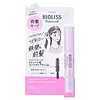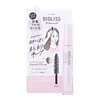What's inside
What's inside
 Key Ingredients
Key Ingredients

 Benefits
Benefits

 Concerns
Concerns

 Ingredients Side-by-side
Ingredients Side-by-side

Water
Skin ConditioningAlcohol Denat.
AntimicrobialPvp
Emulsion StabilisingGlycerin
HumectantMelaleuca Alternifolia Leaf Oil
AntioxidantArgania Spinosa Kernel Oil
EmollientAlthaea Rosea Root Extract
HumectantBifida Polysaccharide
HumectantMentha Citrata Leaf Extract
AstringentCalendula Officinalis Extract
Skin ConditioningSodium Hyaluronate
HumectantPinus Pinaster Leaf Extract
Skin ConditioningLavandula Angustifolia Flower Extract
CleansingRosmarinus Officinalis Water
MaskingHydrolyzed Soy Protein
HumectantButylene Glycol
HumectantDisodium EDTA
PEG-40 Hydrogenated Castor Oil
EmulsifyingCarbomer
Emulsion StabilisingPhenoxyethanol
PreservativeMethylparaben
PreservativeParfum
MaskingWater, Alcohol Denat., Pvp, Glycerin, Melaleuca Alternifolia Leaf Oil, Argania Spinosa Kernel Oil, Althaea Rosea Root Extract, Bifida Polysaccharide, Mentha Citrata Leaf Extract, Calendula Officinalis Extract, Sodium Hyaluronate, Pinus Pinaster Leaf Extract, Lavandula Angustifolia Flower Extract, Rosmarinus Officinalis Water, Hydrolyzed Soy Protein, Butylene Glycol, Disodium EDTA, PEG-40 Hydrogenated Castor Oil, Carbomer, Phenoxyethanol, Methylparaben, Parfum
Water
Skin ConditioningAlcohol Denat.
AntimicrobialPvp
Emulsion StabilisingGlycerin
HumectantMelaleuca Alternifolia Leaf Oil
AntioxidantArgania Spinosa Kernel Oil
EmollientAlthaea Rosea Root Extract
HumectantSuizendinori Polysaccharide
Mentha Citrata Leaf Extract
AstringentCalendula Officinalis Flower Extract
MaskingSodium Hyaluronate
HumectantPinus Pinaster Leaf Extract
Skin ConditioningLavandula Angustifolia Flower Extract
CleansingWater, Alcohol Denat., Pvp, Glycerin, Melaleuca Alternifolia Leaf Oil, Argania Spinosa Kernel Oil, Althaea Rosea Root Extract, Suizendinori Polysaccharide, Mentha Citrata Leaf Extract, Calendula Officinalis Flower Extract, Sodium Hyaluronate, Pinus Pinaster Leaf Extract, Lavandula Angustifolia Flower Extract
Ingredients Explained
These ingredients are found in both products.
Ingredients higher up in an ingredient list are typically present in a larger amount.
Alcohol Denat. is an alcohol with a denaturant property. It is created by mixing ethanol with other additives.
This ingredient gets a bad rep because it is irritating and drying - mostly due to its astringent property. Astringents draw out natural oils in tissue, constricting pores and leaving your skin dried out.
However, alcohol denat. is not all that bad.
Due to its low molecular weight, alcohol denat. tends to evaporate quickly. One study on pig skin found half of applied alcohol evaporated in 10 seconds and less than 3% stayed on skin.
This also helps other ingredients become better absorbed upon application.
Studies are conflicted about whether this ingredient causes skin dehydration. One study from 2005 found adding emollients to propanol-based sanitizer decreased skin dryness and irritation. Another study found irritation only occurs if your skin is already damaged.
Small amounts of alcohol are generally tolerated by oily skin or people who live in humid environments.
The rule of thumb is if this alcohol is near the end of an ingredients list, it will probably not affect your skin much.
Also...
This ingredient has antimicrobial and solvent properties.
The antimicrobial property helps preserve products and increase their shelf life. As a solvent, it helps dissolve other ingredients.
Other types of astringent alcohols include:
Learn more about Alcohol Denat.We don't have a description for Althaea Rosea Root Extract yet.
You may know this ingredient as argan oil. Argan Oil has antioxidant, hydrating, and soothing properties.
Studies have shown argan oil can help fight again radical damage from the sun. This makes it effective at preventing hyperpigmentation.
Large amounts of vitamin E found in argan oil helps the skin retain water. Argan oil also contains fatty acids such as linoleic acid, oleic acid, and palmitic acid. It is also a good source of lipids.
Another benefit of argan oil is skin-soothing. It can help reduce inflammation-related skin symptoms.
Argan Oil is effective at regulating sebum production in pores. This can make it effective at treating hormonal acne.
Traditionally, argan oil was used for its antibacterial and antifungal properties. However, argan oil contains fatty acids that may make it not fungal-acne safe.
Argan Trees are native to Morocco.
Learn more about Argania Spinosa Kernel OilGlycerin is already naturally found in your skin. It helps moisturize and protect your skin.
A study from 2016 found glycerin to be more effective as a humectant than AHAs and hyaluronic acid.
As a humectant, it helps the skin stay hydrated by pulling moisture to your skin. The low molecular weight of glycerin allows it to pull moisture into the deeper layers of your skin.
Hydrated skin improves your skin barrier; Your skin barrier helps protect against irritants and bacteria.
Glycerin has also been found to have antimicrobial and antiviral properties. Due to these properties, glycerin is often used in wound and burn treatments.
In cosmetics, glycerin is usually derived from plants such as soybean or palm. However, it can also be sourced from animals, such as tallow or animal fat.
This ingredient is organic, colorless, odorless, and non-toxic.
Glycerin is the name for this ingredient in American English. British English uses Glycerol/Glycerine.
Learn more about GlycerinLavandula Angustifolia Flower Extract comes from the lavender plant.
Many components of lavender flowers are antioxidants, such as ferulic acid, caffeic acid, and several flavonoids.
Traditional Iranian folk medicine uses Lavender extract to help treat inflammation.
Lavender extract may have a scent.
It contains linalool, a known allergen. However, lavender extract contains less linalool than lavender essential oil.
Learn more about Lavandula Angustifolia Flower ExtractThis tea tree oil comes from the leaves of the Tea Tree plant. Tea tree oil has antioxidant, anti-inflammatory, and antimicrobial properties.
According to the book Journal of Profiles of Drug Substances, tea tree helps in reducing acne-causing bacteria such as Propionibacterium acnes. This is due to the Terpinen components of tea tree oil.
Tea tree may cause sensitivity and irritation for some people. This oil naturally contains fragrance such as linalool and limonene.
However, research shows irritation usually occurs when using pure tea tree oil and not in cosmetic products.
Tea tree oil was found to help relieve the symptoms of psoriasis in one study.
Tea tree oil is toxic when ingested. Another study showed it to caused damage to the nervous system of dogs and cats when applied to their skin or given orally.
Learn more about Melaleuca Alternifolia Leaf OilMentha Citrata Leaf Extract is a fragrance.
We don't have a description for Pinus Pinaster Leaf Extract yet.
Pvp is a water-soluble synthetic polymer and common hairstyling ingredient. It is a film-forming ingredient and used to "hold" specific shapes of hair.
Pvp is less effective in high-humidity. It tends to draw moisture, but this moisture dismantles the structure and "hold".
Sodium Hyaluronate is hyaluronic acid's salt form. It is commonly derived from the sodium salt of hyaluronic acid.
Like hyaluronic acid, it is great at holding water and acts as a humectant. This makes it a great skin hydrating ingredient.
Sodium Hyaluronate is naturally occurring in our bodies and is mostly found in eye fluid and joints.
These are some other common types of Hyaluronic Acid:
Learn more about Sodium HyaluronateWater. It's the most common cosmetic ingredient of all. You'll usually see it at the top of ingredient lists, meaning that it makes up the largest part of the product.
So why is it so popular? Water most often acts as a solvent - this means that it helps dissolve other ingredients into the formulation.
You'll also recognize water as that liquid we all need to stay alive. If you see this, drink a glass of water. Stay hydrated!
Learn more about Water